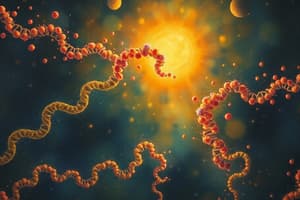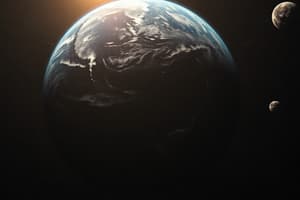Podcast
Questions and Answers
What was the aim of the Miller-Urey experiment?
What was the aim of the Miller-Urey experiment?
- To study the impact of lightning on organic compounds
- To investigate the RNA world hypothesis
- To prove the concept of spontaneous generation
- To simulate the early Earth's conditions (correct)
According to the primordial soup hypothesis, what was the origin of life on Earth?
According to the primordial soup hypothesis, what was the origin of life on Earth?
- Meteoric impacts
- Deep hot biosphere
- Mixtures of organic molecules in early seas (correct)
- Panspermia
Which hypothesis suggests that life may have originated from organic materials brought to Earth by meteorites or comets?
Which hypothesis suggests that life may have originated from organic materials brought to Earth by meteorites or comets?
- RNA world hypothesis
- Panspermia hypothesis (correct)
- Deep hot biosphere hypothesis
- Spontaneous generation hypothesis
What does abiogenesis refer to?
What does abiogenesis refer to?
Which theory proposes that life emerged from a gradual formation of RNA molecules before the evolution of DNA-based life forms?
Which theory proposes that life emerged from a gradual formation of RNA molecules before the evolution of DNA-based life forms?
What concept refers to the idea that living organisms can be formed from nonliving matter under certain conditions?
What concept refers to the idea that living organisms can be formed from nonliving matter under certain conditions?
Which hypothesis suggests that RNA played a central role in the origins of life?
Which hypothesis suggests that RNA played a central role in the origins of life?
What theory proposes that life exists throughout the universe and could have been transported to Earth via asteroids or comets?
What theory proposes that life exists throughout the universe and could have been transported to Earth via asteroids or comets?
Which hypothesis was once considered a viable theory for the origin of life but has been discredited since then?
Which hypothesis was once considered a viable theory for the origin of life but has been discredited since then?
Which hypothesis proposes that life originated not in the ocean, but on land, possibly in clay beds?
Which hypothesis proposes that life originated not in the ocean, but on land, possibly in clay beds?
What theory suggests that the Earth's deep crust contains habitable environments where microbes survive using chemosynthesis?
What theory suggests that the Earth's deep crust contains habitable environments where microbes survive using chemosynthesis?
Which hypothesis suggests that life's beginnings can be explained without invoking supernatural intervention?
Which hypothesis suggests that life's beginnings can be explained without invoking supernatural intervention?
Flashcards are hidden until you start studying
Study Notes
Origin of Life: An Overview
The origin of life is a fundamental question in biology, chemistry, and astrobiology. This topic explores various theories and experiments aimed at understanding how life emerged from non-living matter. The following sections will delve into several key theories, experiments, and hypotheses, shedding light on the fascinating journey of life's beginnings.
Miller-Urey Experiment
The Miller-Urey experiment, conducted by Stanley Miller and Harold Urey in 1953, aimed to simulate the conditions believed to exist during Earth's early stages. They created a system containing methane, ammonia, hydrogen, water vapor, and sparks, simulating lightning strikes. Although the results were not initially taken seriously due to its simplicity, it demonstrated that organic compounds could form under conditions similar to those thought to exist during Earth's formation.
Primordial Soup Hypothesis
The primordial soup hypothesis suggests that life began as a mixture of organic molecules in our planet's early seas, eventually evolving through natural selection into the first living organisms. This theory posits that these complex organic molecules created by the Miller-Urey experiment could have formed the basis of this 'primordial soup', providing the raw materials necessary for life's emergence.
Abiogenesis
Abiogenesis refers to the process by which non-living matter gives rise to living beings. Its proponents argue that the complexity required to explain the development of modern cells can be explained without invoking supernatural intervention. However, while the conditions responsible for the transition between non-life and life remain unclear, abiogenesis remains a plausible explanation for the origin of life.
RNA World Hypothesis
The RNA world hypothesis proposes that RNA played a central role in the origins of life, serving both genetic and catalytic functions before DNA and proteins evolved. This theory is based on the observation that RNA molecules can perform the roles of both genes and enzymes. While not universally accepted, the RNA world hypothesis provides an intriguing perspective on life's beginnings.
Panspermia
Panspermia is the idea that life exists throughout the universe and that Earth may have been seeded with microorganisms from space. According to this theory, life forms could have been transported here via asteroids or comets carrying organic molecules, allowing life to start on Earth.
Spontaneous Generation
Spontaneous generation was once considered a viable theory for the origin of life. It proposed that simple animals and plants sprang directly from other matter, such as rotten meat or dung. Thankfully, this theory has since been discredited and replaced by more scientific explanations.
Deep Hot Biosphere
The deep hot biosphere hypothesis argues that the Earth's deep crust contains habitable environments where microbes survive using chemosynthesis and chemoautotrophy. While this concept challenges the traditional view of life existing only within the atmospheric envelope, there is ongoing debate regarding its validity.
Clay Hypothesis
The clay hypothesis suggests that life originated not in the ocean, but on land, in the form of a fibrous microbe growing in clay beds. Similar to the RNA world hypothesis, it also proposes that RNA played a crucial role in life's emergence. Like many other theories, however, its acceptance relies heavily on future discoveries and technological advances.
Studying That Suits You
Use AI to generate personalized quizzes and flashcards to suit your learning preferences.



